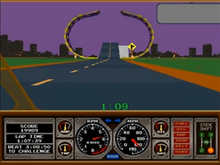

This article needs additional citations for verification. Please help improve this articlebyadding citations to reliable sources. Unsourced material may be challenged and removed.
Find sources: "Race Drivin'" – news · newspapers · books · scholar · JSTOR (October 2018) (Learn how and when to remove this message) |
| Race Drivin' | |
|---|---|
 | |
| Developer(s) | Atari Games (arcade) Argonaut Software (GB) Imagineering Inc. (SNES) Polygames (Genesis) |
| Publisher(s) | Atari Games (arcade) Domark THQ (SNES/GB) Tengen (Genesis) Time Warner Interactive (Saturn/PlayStation) |
| Designer(s) | Rick Moncrief |
| Programmer(s) | Stephanie Mott |
| Artist(s) | Sam Comstock Will Noble Kris Moser Deborah Short |
| Composer(s) | Don Diekneite (arcade) David Whittaker (GB) Mark Van Hecke (SNES) |
| Platform(s) | Arcade, MS-DOS, SNES, Amiga, Game Boy, Genesis, Saturn, PlayStation |
| Release | August 10, 1990 July 26, 1991 MS-DOS 1992 SNES, Amiga
|
| Genre(s) | Driving simulation |
| Mode(s) | 1-2 players alternating |
Race Drivin' is a driving arcade game originally released by Atari Games in 1990. Players must test drive several high-powered sports cars on stunt and speed courses. The game is the sequel to 1989's Hard Drivin' and was part of a new generation of games that featured 3D polygon environments. Unlike most racing games of its time, it attempted to model real world car physics in the simulation of the movement of the player's car. Like Hard Drivin', the game is unique among video games in that it includes a true force feedback steering wheel, an ignition key, a four-speed shifter, and three foot pedals: an accelerator, a brake, and a clutch (the clutch being a control seldom seen in any video game, then or now). Released in August 1990, approximately 1200 units were produced at the time of its release for roughly US$9,000 (equivalent to $21,000 in 2023) each.[3]
Race Drivin' was ported to a number of home systems in the mid-1990s, including the SNES, Amiga, MS-DOS, Game Boy, PlayStation, Genesis and Saturn. In 2005, it was included in the Midway Arcade Treasures 3 collection for the PlayStation 2, GameCube, and Xbox.

The gameplay resembles a driving game, featuring 4 different cars (3 with manual transmissions (speedster, roadster, and original), and 1 automatic (original)) and 3 different tracks to choose from (the regular stunt track which is very similar to the one in Hard Drivin', the Autocross track, and the Super Stunt track). The screen shows a first person perspective from inside the car, through the windshield. The car's dashboard is visible and displays the car's instruments, like the speedometer, tachometer and fuel level, as well as a few other non-gameplay important ones, such as the oil, temp, and amp dummy lights. Each car has its own unique dashboard.
The game generally consists of racing 1 or 2 laps around the player's chosen track within the allotted time. The gameplay and vehicle operation in Race Drivin' are very similar to Hard Drivin' and gameplay elements such as the Instant Replay and the off-road timer are still there. A noticeable difference between the two games though is that although the car traffic in Race Drivin's stunt track is still there like in the original Hard Drivin' track, the two new tracks included in Race Drivin' (Autocross and Super Stunt track) are absent of any additional car traffic. Also, unlike Hard Drivin's original track that offers the driver two different driving paths, the two new tracks in Race Drivin' only offer one driving path per track. The finish times of the new tracks are very different as well. The original track shared by Race Drivin' and Hard Drivin' takes roughly 1:30 to complete. By comparison, the Autocross track is very short requiring roughly only 30 seconds to complete and the Super Stunt track is considerably longer (taking roughly 3 minutes to complete).
Like its predecessor Hard Drivin', the game features an ignition key, a realistic manual transmission mode (which includes a 4-speed shifter (with neutral), a clutch pedal, and the possibility of stalling the car should one mis-shift) and a force feedback steering wheel, in which the driver has to all properly operate as they would in a car in real life. The cockpit version of the game also includes an adjustable bucket seat and, if it is a 'Panorama' version (only 100 of which were made), it sports 3 to 5 monitors for a full 180° peripheral view.[4]
Race Drivin' improved upon its predecessor in several ways:
Doug Milliken, who also worked on Hard Drivin', is credited as a "test driver", but actually worked as a consultant for developing the car model. This model was used to lay out the physics of the game's car.[5][6] The arcade version of Race Drivin' was exhibited at the UK's Amusement Trades Exhibition International (ATEI) in 1991.[7]
| Publication | Score |
|---|---|
| Electronic Gaming Monthly | 23/50 (Genesis)[8] |
| GameSpot | 6.3/10 (XBOX)[9] |
| Nintendo Power | 9.7/20 (SNES)[10] 12.5/20 (Game Boy)[11] |
| Super Play | 35% (SNES)[12] |
| Sega Pro | 80% (Mega Drive)[13] |
In North America, the arcade version was the top new video game on the RePlay arcade charts in October 1990,[14] and then the top upright arcade cabinet from November 1990[15][16] through early 1991[17][18][19] to May 1991.[20][21] Race Drivin' Panorama was later the top new arcade video game in August 1991.[22]
Electronic Gaming Monthly gave the Genesis version 23 out of 50, calling it "another so-so entry in the driving scene" due to its "very choppy" scrolling.[8]
| Authority control databases: National |
|
|---|